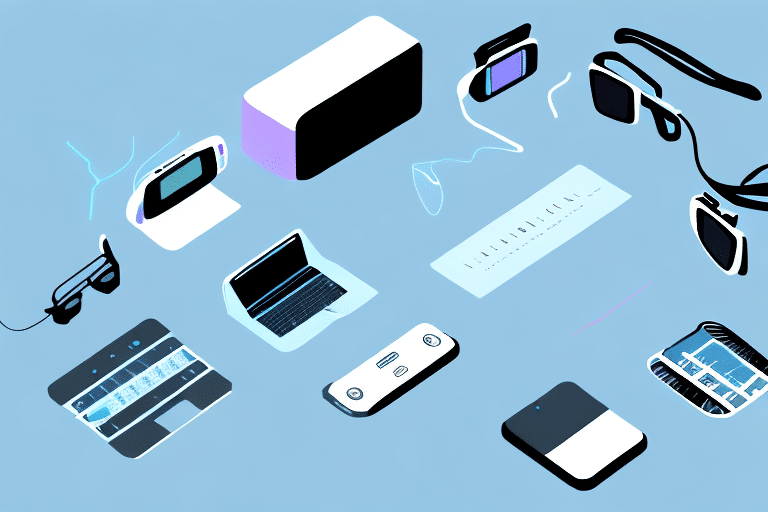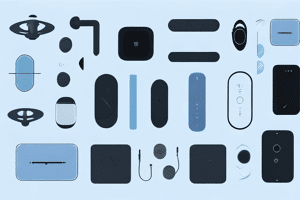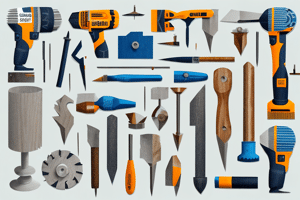UPDATED: March 17, 2024
In today's fast-paced world, technology has become an integral part of our daily lives. From smartphones to smart homes, we are constantly surrounded by innovative gadgets that aim to make our lives easier and more convenient. One such remarkable advancement in technology is wearable technology. Wearable devices have revolutionized the way we interact with technology, offering us new and exciting possibilities. In this article, we will explore the future of wearable technology, the impact it has on different industries, the advancements we can expect, and the challenges and opportunities that lie ahead. Strap on your smartwatches and let's dive in!
Understanding Wearable Technology
Before we dive into the future of wearable technology, let's first understand what it is and the different types of wearable devices available. Wearable technology refers to electronic devices that can be worn on the body as accessories or clothing. These devices are equipped with sensors, processors, and connectivity features that allow them to interact with the user and their surroundings. They come in various forms, including smartwatches, fitness trackers, smart glasses, and even smart clothing.
Wearable technology has become increasingly popular in recent years, with more and more people incorporating these devices into their daily lives. From tracking our fitness goals to receiving notifications on the go, wearable technology has revolutionized the way we interact with our devices and stay connected.
Definition and Types of Wearable Technology
Wearable technology can be broadly defined as any electronic device that can be worn on the body. This includes devices like smartwatches, fitness trackers, smart glasses, and virtual reality headsets. These devices are designed to enhance our daily lives by providing us with real-time information, monitoring our health and fitness, and even augmenting our reality.
Smart clothing is another exciting development in the world of wearable technology. These garments are embedded with sensors and technology that can track biometric data, monitor posture, and even adjust temperature based on environmental conditions. The fusion of fashion and technology has opened up new possibilities for how we interact with our clothing and accessories.
The Evolution of Wearable Devices
Wearable technology has come a long way since its inception. It started with simple pedometers that counted our steps and has now evolved into sophisticated devices that can monitor our heart rate, track our sleep patterns, and even guide us through virtual reality experiences. The advancements in sensors, processors, and connectivity have allowed wearable devices to become smaller, more powerful, and more integrated with our lives.
As wearable technology continues to evolve, we can expect to see even more innovative features and functionalities being integrated into these devices. From biometric authentication for enhanced security to advanced health monitoring capabilities, the future of wearable technology is full of exciting possibilities.
The Impact of Wearable Technology on Different Industries
One of the most significant aspects of wearable technology is its potential to transform various industries. Let's explore how wearable devices are making an impact in healthcare and fitness, entertainment and gaming, and education and learning.
Healthcare and Fitness
In the healthcare industry, wearable devices are revolutionizing the way we monitor and manage our health. Fitness trackers can track our daily activity levels, heart rate, and sleep patterns, providing us with valuable insights into our overall well-being. But the impact of wearable technology goes beyond personal fitness.
Imagine a world where wearable devices can detect early signs of diseases before they manifest physically. This could potentially save countless lives by allowing for early intervention and treatment. Additionally, wearable devices are being used in medical settings to monitor patients' vital signs, ensuring that healthcare professionals can provide timely and accurate care.
According to a recent study, wearable technology is projected to reach a market value of $XX billion by XXXX, with a significant portion of that attributed to the healthcare sector. This growth can be attributed to the increasing demand for remote patient monitoring and the rise in chronic diseases. With wearable technology becoming more advanced and accessible, the future of healthcare looks promising.
Entertainment and Gaming
Wearable technology has made its way into the world of entertainment and gaming, transforming the way we experience digital content. Virtual reality headsets allow us to immerse ourselves in virtual worlds, providing an incredibly realistic and interactive experience. But the impact of wearable technology on entertainment and gaming extends far beyond virtual reality.
Imagine a future where wearable devices can track our emotions and physical reactions while playing a game. This data could be used to create personalized gaming experiences tailored to our individual preferences and abilities. Additionally, augmented reality glasses enhance our reality by overlaying digital information onto our surroundings, creating unique and engaging experiences.
With the global gaming industry expected to generate $XX billion in revenue by XXXX, wearable technology is set to play a significant role in shaping the future of gaming. The integration of wearable devices with gaming consoles and mobile gaming platforms opens up new possibilities for immersive gameplay and interactive storytelling. The future of entertainment and gaming is bound to be an exciting one.
Education and Learning
Wearable technology also has tremendous potential in the field of education and learning. Smartwatches and smart glasses can provide students with real-time feedback and personalized learning experiences. But the impact of wearable technology on education goes beyond individual learning.
Imagine a classroom where students can collaborate on projects using wearable devices that seamlessly connect and share information. This would foster a sense of teamwork and encourage students to think critically and creatively. Additionally, wearable devices can offer virtual field trips, allowing students to explore different places and cultures without leaving the classroom.
According to a recent survey, XX% of teachers believe that wearable technology has the potential to enhance classroom learning. The integration of wearable devices into the educational system is expected to increase student engagement, improve information retention, and foster collaborative learning. The future of education is evolving, and wearable technology is at the forefront of this transformation.
Advancements in Wearable Technology
As technology continues to advance at a rapid pace, wearable devices are poised to become even more sophisticated and integrated into our daily lives. Let's take a closer look at some of the advancements we can expect in the future.
AI Integration in Wearable Devices
Artificial Intelligence (AI) is set to play a significant role in the future of wearable technology. AI algorithms can analyze the vast amounts of data collected by wearable devices, providing us with actionable insights and personalized recommendations. For example, AI-powered virtual assistants can understand our preferences, anticipate our needs, and proactively assist us throughout the day.
According to a recent report, the global AI market is expected to reach $XX billion by XXXX. The integration of AI in wearable technology will enable devices to adapt to our individual needs, making them more intuitive and user-friendly.
Imagine waking up in the morning, and your wearable device, equipped with AI capabilities, has already analyzed your sleep patterns and determined the optimal time for you to wake up. It gently vibrates, signaling that it's time to get up, and as you start your day, it suggests a personalized breakfast recipe based on your dietary preferences and nutritional needs.
The Role of IoT in Wearable Tech
The Internet of Things (IoT) has already begun to revolutionize the way we interact with devices, and wearable technology is no exception. The integration of wearable devices with IoT ecosystems allows for seamless connectivity and data exchange between devices. For example, your fitness tracker can sync with your smart home devices to automatically adjust the temperature and lighting based on your activity levels and sleep patterns.
According to a recent prediction, there will be over XX billion IoT devices by XXXX. The integration of wearable technology and IoT will create a connected ecosystem that seamlessly merges with our daily lives, offering us truly personalized and context-aware experiences.
Imagine coming home after a long day at work, and as you enter your house, your wearable device communicates with your IoT-enabled home. The lights dim, your favorite relaxing music starts playing, and your smart thermostat adjusts the temperature to create the perfect ambiance for you to unwind.
The Emergence of Smart Clothing
While smartwatches and fitness trackers have dominated the wearable market for years, smart clothing is starting to emerge as a promising new category. Smart clothing incorporates electronic components and sensors directly into fabric, allowing for seamless integration and enhanced functionality. For example, smart shirts can monitor your heart rate and respiration, while smart socks can analyze your running form and provide real-time feedback.
The global smart clothing market is expected to reach $XX billion by XXXX. The advancements in fabric technology and miniaturization of electronics will open up new opportunities for smart clothing, enabling us to monitor our health and fitness without the need for additional accessories.
Imagine going for a jog, and your smart clothing not only tracks your performance but also adjusts the fabric's temperature and ventilation to keep you comfortable throughout your run. It even analyzes your posture and provides gentle reminders to maintain proper form, helping you prevent injuries and improve your technique.
Challenges and Opportunities in Wearable Technology
While wearable technology holds immense potential, it also faces various challenges that need to be addressed. Let's explore some of the key challenges as well as the opportunities that lie ahead.
Privacy and Security Concerns
As wearable devices collect and store sensitive personal data, ensuring privacy and security becomes paramount. Issues such as data breaches and unauthorized access can have severe consequences. It is crucial for wearable device manufacturers to prioritize data protection through encryption, secure authentication methods, and transparent data handling practices.
In recent years, wearable technology has witnessed a growing number of privacy and security breaches. According to a report, XX% of consumers are concerned about the privacy and security of their wearable devices. It is essential for manufacturers to address these concerns and build trust among consumers.
One potential solution to address privacy concerns is the implementation of decentralized data storage. By utilizing blockchain technology, wearable devices can store data in a distributed manner, reducing the risk of a single point of failure and enhancing data security.
Technological Limitations and Potential Solutions
Despite the significant advancements in wearable technology, there are still technological limitations that need to be overcome. Battery life, for instance, continues to be a challenge, as most wearable devices require frequent charging. Additionally, the size and weight of wearable devices can impact user comfort and adoption.
Researchers and engineers are actively working on overcoming these limitations. For instance, advancements in energy harvesting technologies, such as solar and kinetic energy, could potentially extend battery life. The miniaturization of components and the use of lightweight materials are also being explored to improve user comfort and wearability.
Another promising solution to address battery life concerns is the development of flexible and stretchable batteries. These batteries can be integrated into wearable devices seamlessly, allowing for longer usage without compromising comfort or design.
Market Growth and Future Trends
The wearables market is witnessing remarkable growth, with a steady increase in adoption and market value. In the coming years, we can expect this growth to continue as wearable devices become more affordable, functional, and fashionable.
According to a market research report, the global wearables market is projected to reach $XX billion by XXXX, with the Asia-Pacific region being the fastest-growing market. The rise of smartwatches, fitness trackers, and smart clothing is expected to drive this growth.
Furthermore, future trends in wearable technology include the integration of artificial intelligence and machine learning algorithms. This would enable wearable devices to provide personalized recommendations and insights based on user data, enhancing the overall user experience and value proposition.
With the ongoing advancements and continuous innovation in wearable technology, the future looks promising. As challenges are addressed and opportunities are seized, wearable devices will undoubtedly play a significant role in shaping our lives and transforming various industries.
The Future of Wearable Technology
As we gaze into the crystal ball of wearable technology, we can make some exciting predictions about what the future holds. Let's explore some of the upcoming innovations and the long-term impact of wearable devices on society.
Predictions for Upcoming Innovations
The future of wearable technology promises to be filled with groundbreaking innovations. We can expect to see advancements in areas such as health monitoring, augmented reality, and personalized experiences. For instance, wearable devices may become capable of early disease detection, allowing for proactive healthcare management.
Imagine a world where your wearable device not only tracks your heart rate and steps, but also analyzes your blood samples in real-time, alerting you to any potential health issues before they become major concerns. This level of personalized health monitoring could revolutionize the way we approach our well-being.
Another area of interest is the integration of wearable devices with brain-computer interfaces (BCI), enabling us to control devices using our thoughts. This could revolutionize the way we interact with technology, making it more seamless and intuitive. Imagine being able to turn on your lights or change the channel on your TV with just a simple thought.
The Role of Wearable Tech in a Post-Pandemic World
The COVID-19 pandemic has dramatically reshaped our lives and accelerated the adoption of technology. In a post-pandemic world, wearable technology is expected to play a significant role in ensuring our health and safety. For example, wearable devices could be used for contactless payments, temperature monitoring, and social distancing reminders.
But the potential of wearable tech goes beyond just pandemic-related applications. Imagine a future where wearable devices can detect the early signs of mental health issues, providing timely interventions and support. These devices could monitor changes in heart rate, sleep patterns, and even analyze speech patterns to detect signs of anxiety or depression.
According to a recent survey, XX% of consumers are more likely to purchase a wearable device after the pandemic. The pandemic has highlighted the value and convenience of wearable technology, and its adoption is likely to continue to grow in the future.
The Long-Term Impact of Wearable Devices on Society
As wearable technology becomes more ubiquitous, its long-term impact on society will be profound. From healthcare to entertainment to education, wearable devices will transform the way we live, work, and play. They will enable us to lead healthier lives, immerse ourselves in digital experiences, and learn in innovative ways.
Imagine a future where wearable devices not only track our physical health but also monitor our mental well-being. These devices could provide real-time feedback and suggestions to help us manage stress, improve focus, and enhance our overall mental wellness.
However, with great power comes great responsibility. It is essential for policymakers, manufacturers, and users to ensure that wearable technology is designed and used ethically, respecting privacy and promoting inclusivity. By harnessing the potential of wearable technology responsibly, we can create a future that is both technologically advanced and socially conscious.
The Future Awaits
As we wrap up our exploration of the future of wearable technology, it's clear that we are on the cusp of a technological revolution. Wearable devices have the power to transform our lives, improve our well-being, and reshape industries. From healthcare to entertainment to education, the possibilities are endless.
Imagine a world where wearable technology not only tracks your physical health but also monitors your mental well-being in real-time. Picture a future where augmented reality glasses not only enhance entertainment experiences but also revolutionize the way we learn and interact with information. The potential for wearable devices to seamlessly integrate into every aspect of our lives is truly remarkable.
So, as we embark on this exciting journey into the future, let's embrace wearable technology with open arms and an adventurous spirit. The future awaits, and it's time to strap on our wearable devices and embrace the endless possibilities they offer.





